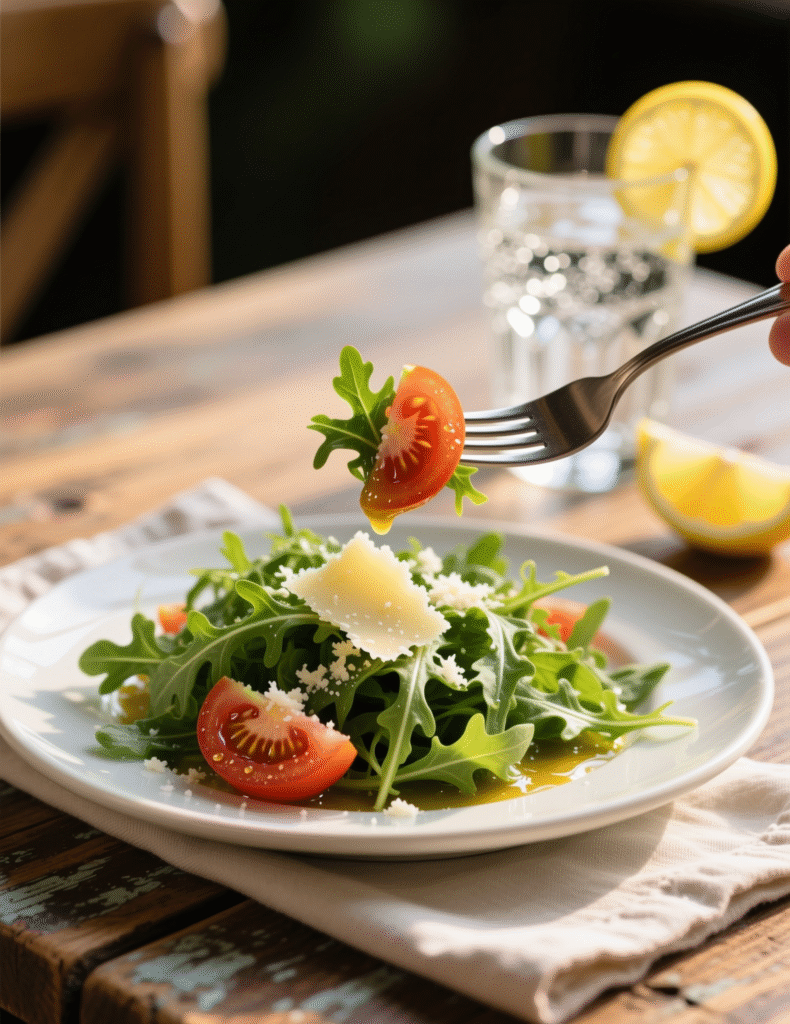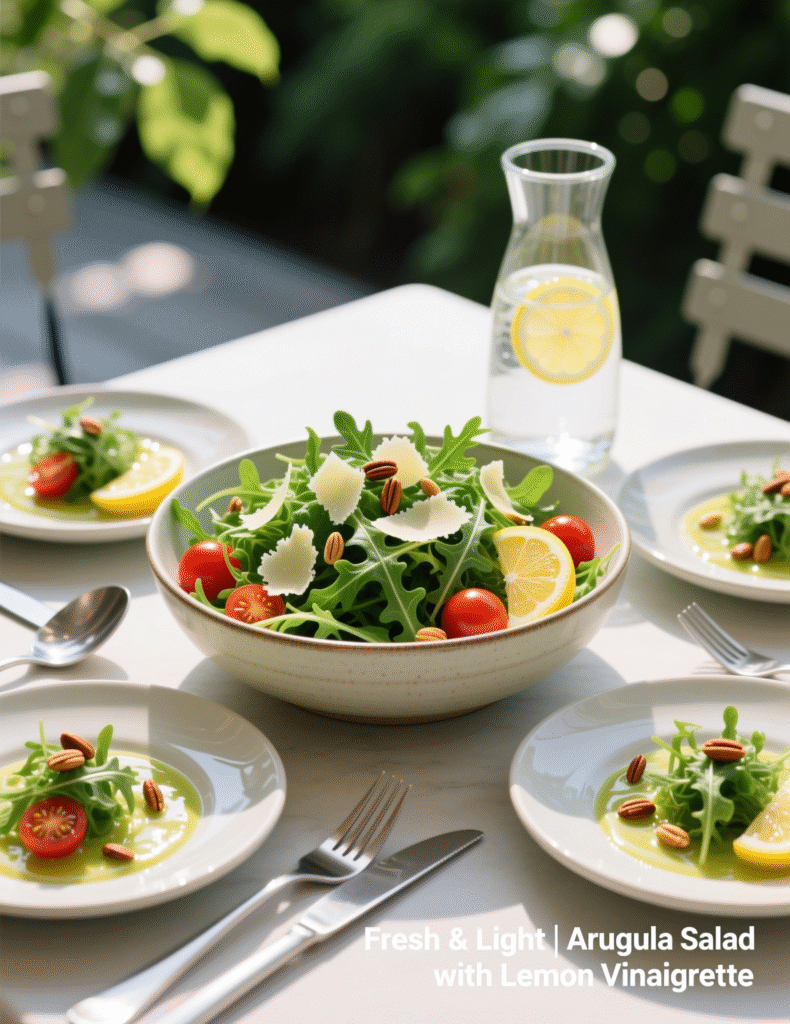Sometimes, the simplest dishes speak the loudest. This Arugula Salad with Lemon Vinaigrette Recipe for 4 servings isn’t just another bowl of greens—it’s a sharp, peppery whisper of freshness that wakes your palate right up. It’s the kind of dish that looks effortless but reveals a chef’s understanding of balance, texture, and restraint. Professionals know: simplicity is the hardest to master.
The Beauty Behind Arugula: Not Just Another Green
Arugula (or rocket, as it’s called across the Atlantic) has character. It’s not the polite kind of lettuce that stays quiet under dressing. It fights back—with peppery, nutty notes that demand the right partners. Botanically, arugula belongs to the Brassicaceae family, alongside mustard and broccoli. That explains its bite.
Interestingly, arugula wasn’t always a salad darling. In ancient Rome, it was considered an aphrodisiac, often mixed with dandelion and herbs. Fast-forward to modern kitchens—Michelin-starred chefs now use it as a palate brightener, tossing it into warm grains, shaving it over pizza, or pairing it with citrus.
But here’s the secret: the best arugula salads aren’t overloaded. They let the leaves breathe. The vinaigrette should kiss, not drown.
The Soul of the Dish: Lemon Vinaigrette
Now, let’s talk vinaigrette—the heartbeat of this recipe. Lemon vinaigrette is one of those dressings that can make or break a salad. It’s deceptively simple: lemon juice, olive oil, a dab of Dijon, maybe a touch of honey. But balance is everything. Too acidic, and it overpowers. Too oily, and it feels heavy.
Professional chefs often rely on ratios rather than recipes. The classic French formula—3 parts oil to 1 part acid—serves as a starting point. But for lemon-based dressings, that shifts slightly. Lemons are less sharp than vinegars, so a 2:1 ratio can feel brighter, cleaner.
Use extra-virgin olive oil. The good kind. The one that smells like freshly cut grass. A cold-pressed oil gives body and a fruity undertone that plays beautifully with lemon’s tang.

Ingredients You’ll Need (for 4 servings)
For the Salad:
- 5 oz (about 6 cups) fresh arugula, washed and dried
- 1/3 cup shaved Parmesan cheese
- 1 small shallot, thinly sliced
- 1 cup cherry tomatoes, halved
- 1 ripe avocado, sliced (optional but heavenly)
- Freshly cracked black pepper, to taste
For the Lemon Vinaigrette:
- 1/4 cup fresh lemon juice (from about 2 lemons)
- 1/2 teaspoon Dijon mustard
- 1 teaspoon honey or pure maple syrup
- 1/2 cup extra-virgin olive oil
- Sea salt, to taste
- Freshly ground black pepper
Step-by-Step: Crafting the Perfect Balance
1. Whisk with Intention.
In a small bowl, whisk together lemon juice, Dijon, and honey. The mustard acts as an emulsifier—it helps bind oil and acid together so your dressing doesn’t separate like a moody vinaigrette gone wrong.
2. Add Oil Slowly.
Pour in olive oil gradually while whisking. Don’t rush. Think of it as building texture. When done right, the vinaigrette thickens slightly, taking on a glossy sheen. Add salt and pepper to taste.
3. Taste Like a Pro.
Dip a piece of arugula into the dressing. Taste it. Adjust. Maybe a touch more lemon, maybe a pinch more salt. A true chef never measures blindly; they listen to the food.
4. Assemble with Care.
Place the arugula in a large bowl. Add shallots, cherry tomatoes, and avocado slices. Drizzle the vinaigrette just before serving—about 2 tablespoons to start. Toss gently with your hands (yes, hands) so every leaf gets a light coating without being drenched.
5. Finish Strong.
Top with shaved Parmesan and a twist of fresh pepper. Serve immediately. Arugula wilts faster than most greens under acid, so timing is key.
Why This Salad Works So Well
At its core, this salad is a study in contrasts. Peppery vs. tart. Creamy vs. crisp. Rich vs. bright.
The arugula brings the bite, the lemon vinaigrette brings clarity, and the Parmesan adds umami depth that rounds everything out. That’s why professional chefs often describe it as a “three-note symphony”—each ingredient distinct yet harmonious.
Nutritionally, it’s smart too. Arugula is rich in vitamin K, folate, and antioxidants. A 100-gram serving provides nearly 25% of your daily calcium needs. Lemon juice, meanwhile, enhances iron absorption from greens—a small biochemical detail chefs often exploit when designing plant-forward menus.
A Few Tricks from the Pros
1. Chill the Plates.
A cold plate keeps greens crisp longer. It’s a tiny restaurant trick that adds polish to any salad service.
2. Use Microplane Parmesan.
Shaving cheese too thickly can overwhelm the greens. A fine grate melts slightly into the dressing, coating everything lightly.
3. Toast Something Crunchy.
Add a handful of toasted pine nuts or almonds for texture. Texture contrast is often what separates a good salad from a great one.
4. Layer the Dressing.
For catering or prepped salads, drizzle half the dressing at the bottom, toss lightly, then add more on top before serving. This keeps flavor distribution even and greens lively.
Variations Worth Trying
If you’re feeling experimental, this salad’s structure makes it a perfect canvas for seasonal ingredients.
- Summer: Add grilled peaches or watermelon cubes for sweetness.
- Autumn: Try roasted beets and walnuts instead of tomatoes.
- Winter: Swap lemon for blood orange juice, adding a sweeter, more floral touch.
- Spring: Sprinkle in fresh peas or edible flowers for a delicate finish.
Each tweak changes the mood without betraying the essence of the original. That’s what professionals love about modular recipes like this—they adapt to both ingredient seasonality and kitchen creativity.
Understanding the Science of Flavor Balance
When you break it down, every great salad follows a chemical dance. Acidity cuts fat. Fat softens bitterness. Salt amplifies sweetness. That triangle—acid, fat, salt—is the foundation of flavor engineering.
Lemon vinaigrette excels here because lemon acts as both acid and aromatic. The citric acid brightens, while the oils from the peel (if you add a touch of zest) bring a floral dimension. Olive oil, rich in oleic acid, softens the edges. Parmesan, packed with glutamates, boosts umami. It’s flavor chemistry at its most elegant.
Pairing Suggestions for Professionals
In a fine dining setup, this salad works beautifully as a first course before seafood or poultry. Pair it with:
- Grilled salmon: The lemon vinaigrette mirrors the fish’s citrus-based marinades.
- Roast chicken: The peppery greens add lift to the richness of the meat.
- Seared scallops: Their sweetness contrasts the tang, creating balance.
Wine pairing? Go with a crisp Sauvignon Blanc or an unoaked Chardonnay. The bright acidity mirrors the vinaigrette and complements the greens.
Common Mistakes (and How to Avoid Them)
Even seasoned cooks stumble with simple dishes. A few pitfalls to dodge:
Overdressing:
This is the number one sin. Arugula should glisten, not swim. The leaves wilt quickly under too much acid.
Old Lemon Juice:
Fresh lemon juice has vibrancy; bottled versions taste flat. Always squeeze right before making the vinaigrette.
Low-Quality Oil:
Bad olive oil ruins everything. Spend the extra few dollars—it’s worth it.
No Emulsification:
If your vinaigrette separates quickly, it means you rushed the whisking. Patience gives body and smoothness.

A Bit of Kitchen Math
Professional kitchens rely on consistency. For 4 servings, each person gets roughly:
- 1½ cups arugula
- ¼ avocado
- ¼ cup tomatoes
- 1 tablespoon Parmesan
- ½ tablespoon vinaigrette
This ratio maintains both aesthetic balance and flavor equilibrium. Scale up accordingly, but remember: greens compact fast when tossed.
The Professional Edge
Here’s a detail most home cooks miss—temperature control. Vinaigrettes taste different at various temps. When cold, olive oil tightens, muting aroma. When slightly warm (around 80°F), it blooms. That’s why chefs often temper the dressing by setting the oil bottle near a warm stovetop for a few minutes before use.
Another pro move: zest the lemon before juicing. Zest contains essential oils that intensify aroma without extra acid. It’s that invisible layer of complexity diners can’t pinpoint but always feel.
The Modern Shift Toward Simplicity
Fine dining trends have been shifting—away from overworked plates and back to ingredient clarity. This salad embodies that philosophy: clean lines, vibrant flavor, zero pretense. It’s why chefs like Alice Waters or Yotam Ottolenghi have kept such dishes central to their menus. The world’s best plates often start in the garden, not the pantry.
Nutritional Breakdown (Per Serving Approximate)
- Calories: 210
- Fat: 18g (mostly healthy unsaturated fats)
- Carbohydrates: 7g
- Protein: 5g
- Fiber: 2g
- Vitamin K: 120% DV
- Vitamin C: 45% DV
This makes it ideal as a light entrée or side. For professionals designing balanced menus, it pairs well with heavier mains or carb-rich courses, offering a palate-cleansing bridge.
Expert Insight: Why Simplicity Demands Skill
There’s a saying in culinary circles: “It’s harder to hide behind greens.” Complex sauces can disguise imbalance. But a minimalist salad exposes every flaw—temperature, acidity, even the oil’s freshness.
That’s why chefs often test new hires with a salad. It shows their touch. Their restraint. Their respect for ingredients. If you can make a perfect arugula salad, you can probably cook anything.
Conclusion: Precision, Passion, and a Pinch of Lemon
The Arugula Salad with Lemon Vinaigrette Recipe might look humble, but it’s a masterclass in composition. It teaches balance, control, and flavor awareness—all hallmarks of culinary expertise.
So the next time you toss those bright green leaves, remember—this isn’t just a side dish. It’s a statement. A quiet, citrusy reminder that food, at its best, doesn’t shout. It whispers, confidently.
A touch of lemon, a drizzle of oil, and a handful of peppery leaves. Sometimes, that’s all you need to taste perfection.
FAQs
How do you make arugula salad with lemon vinaigrette?
Whisk lemon juice, Dijon, honey, and olive oil, then toss with arugula, tomatoes, shallots, and Parmesan.
What does arugula taste like?
Arugula has a peppery, slightly nutty flavor with a hint of bitterness.
Can I make lemon vinaigrette ahead of time?
Yes, it can be stored in the fridge for up to 5 days in a sealed jar.
What type of olive oil is best for this recipe?
Use extra-virgin olive oil for its fruity, full-bodied flavor.
How do I keep the arugula from wilting?
Dress the salad right before serving and use chilled greens.
Can I substitute lemon with lime?
Yes, lime adds a similar acidity but with a softer, floral tang.
Is arugula salad healthy?
Absolutely, it’s rich in vitamins K and C, folate, and antioxidants.
What can I pair with arugula salad?
It pairs beautifully with grilled fish, roasted chicken, or seared scallops.
Can I add nuts or seeds for crunch?
Yes, toasted almonds, pine nuts, or sunflower seeds work perfectly.
How long does lemon vinaigrette stay emulsified?
It stays stable for a few hours; shake or whisk again before serving.
What cheese works best besides Parmesan?
Try crumbled feta, goat cheese, or shaved pecorino for variation.
Is arugula salad suitable for vegans?
Yes, just skip or replace the Parmesan with a plant-based alternative.
Can I use bottled lemon juice instead of fresh?
Fresh lemon juice is strongly preferred for its bright, clean flavor.
How many servings does this recipe make?
It yields 4 servings—perfect for a light lunch or side salad.
What’s the best way to serve arugula salad?
Serve immediately after tossing to keep the greens crisp and vibrant.

Marie Smith is a passionate recipe blogger, sharing easy, delicious, and creative culinary ideas that inspire home cooks to elevate everyday meals with flavor and simplicity.
